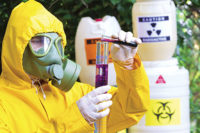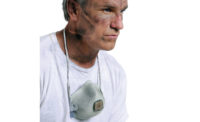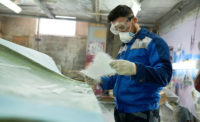OSHA’s respiratory protection standard was the fifth most-frequently cited agency standard in FY 2019.
Enforcement citations FY 2019: 2,530
Number of inspections: 1,130
Proposed penalties: $3,123,375
Most frequently cited industries:
- Manufacturing
- Construction
- Other Services (except Public Administration)
- Wholesale Trade
Application
OSHA's Respiratory Protection Standard applies to general industry, construction, shipyards, marine terminals, and longshoring.
The OSHA respirator standard applies to all occupational airborne exposures to contaminated air where the employee is:
- Exposed to a hazardous level of an airborne contaminant; or
- Required by the employer to wear respirators; or
- Permitted to wear respirators.
Four major duties are imposed by each of these standards. These duties are:
- Use engineering controls where feasible to control the hazard.
- Provide an appropriate respirator.
- Ensure the use of an appropriate respirator.
- Institute a respiratory protection program that complies with the rest of the standard.
Respirator requirements
An estimated five million workers are required to wear respirators in 1.3 million workplaces throughout the United States. Respirators protect workers against insufficient oxygen environments, harmful dusts, fogs, smokes, mists, gases, vapors, and sprays. These hazards may cause cancer, lung impairment, diseases, or death. Compliance with the OSHA Respiratory Protection Standard could avert hundreds of deaths and thousands of illnesses annually.
A respirator is a device that protects you from inhaling dangerous substances, such as chemicals and infectious particles. Respirators are among the most important pieces of protective equipment for working in hazardous environments. Selecting the right respirator requires an assessment of all the workplace operations, processes or environments that may create a respiratory hazard. The identity of the hazard and its airborne concentrations need to be determined before choosing a respirator.
Respirators protect the user in two basic ways. The first is by the removal of contaminants from the air. Respirators of this type include particulate respirators, which filter out airborne particles, and air-purifying respirators with cartridges/canisters which filter out chemicals and gases. Other respirators protect by supplying clean respirable air from another source. Respirators that fall into this category include airline respirators, which use compressed air from a remote source, and self-contained breathing apparatus (SCBA), which include their own air supply.
Particulate respirators are the simplest, least expensive, and least protective of the respirator types available. These respirators only protect against particles (e.g., dust). They do not protect against chemicals, gases, or vapors, and are intended only for low hazard levels. The commonly known "N-95" filtering facepiece respirator or "dust mask" is one type of particulate respirator, often used in hospitals to protect against infectious agents. Particulate respirators are "airpurifying respirators" because they clean particles out of the air as you breathe.
Frequently asked questions about respiratory protection fit testing
What is a respirator fit test?
A fit test is conducted to verify that a respirator is both comfortable and correctly fits the user. Fit test methods are classified as either qualitative or quantitative. A qualitative fit test is a pass/fail test that relies on the individual’s sensory detection of a test agent, such as taste, smell, or involuntary cough (a reaction to irritant smoke). A quantitative fit test uses an instrument to numerically measure the effectiveness of the respirator. The benefits of a fit test include better protection for the employee and verification that the employee is wearing a correctly-fitting model and size of respirator. Higher than expected levels of exposure to a contaminant may occur if the respirator has a poor face seal against the user’s skin, which can result in leakage.
How often must fit testing be conducted?
In addition to fit testing upon initially selecting a model of respirator, OSHA requires that fit testing be conducted annually, and repeated “whenever an employee reports, or the employer or the physician or other licensed health care professional makes visual observations of changes in the employee’s physical condition that could affect respirator fit (e.g., facial scarring, dental changes, cosmetic surgery, or an obvious change in body weight).”
The appropriate length of time between respirator fit tests has been a point of debate and discussion for many years due to its use of workplace time and resources, especially in reference to the commonly-used filtering facepiece respirator (FFR). In response to these concerns, NIOSH completed a study that confirmed the necessity of the current OSHA respirator fit testing requirement, both annually and when physical changes have occurred.
Once I am fit tested, can i use any brand/make/model respirator as long as it is the same size?
A successful fit test only qualifies an employee to use the specific brand/make/model and size of respirator that he or she wore during that test. Respirator sizing is not standardized across models or brands. For example, a medium in one model may not offer the same fit as a different manufacturer’s medium model.
Can I have facial hair and still be fit tested to wear a tight-fitting respirator?
The OSHA respirator standard prohibits tight-fitting respirators to be worn by workers who have facial hair that comes between the sealing surface of the facepiece and the face of the wearer. Facial hair that lies along the sealing area of a respirator, such as beards, sideburns, or some mustaches, will interfere with respirators that rely on a tight facepiece seal to achieve maximum protection. Research tells us that the presence of facial hair under the sealing surface causes 20 to 1000 times more leakage compared to clean-shaven individuals.
Do Powered Air-Purifying Respirators (PAPRs) require fit testing?
The answer to this question depends on the type of facepiece that the respirator has. Any facepieces that form a tight seal to the wearer’s face, e.g., half-masks and full facepieces, must be fit tested. Loose-fitting PAPRs, in which the hood or helmet is designed to form only a partial seal with the wearer’s face or hoods which seal loosely around the wearer’s neck or shoulders, do not require fit testing.
|
2020 Top Standards Article Index ANSI/ISEA 121- Dropped object prevention solutions NFPA 652 standard on fundamentals of combustible dust OSHA most frequently violated standardsFall protection- General Requirements (1926.501) Hazard Communication (1910.1200) The Control of Hazardous Energy (Lockout/Tagout) 1910.147 Respiratory Protection (1910.134) Powered Industrial Trucks (1910.178) |



